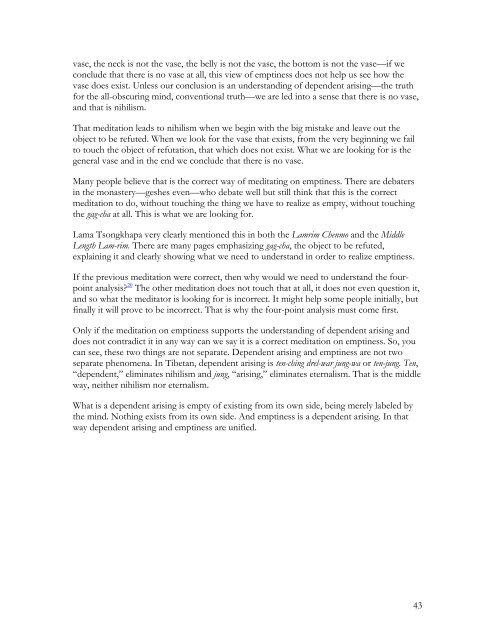Lama Zopa Rinpoche
55OTzl52A
55OTzl52A
You also want an ePaper? Increase the reach of your titles
YUMPU automatically turns print PDFs into web optimized ePapers that Google loves.
vase, the neck is not the vase, the belly is not the vase, the bottom is not the vase—if we<br />
conclude that there is no vase at all, this view of emptiness does not help us see how the<br />
vase does exist. Unless our conclusion is an understanding of dependent arising—the truth<br />
for the all-obscuring mind, conventional truth—we are led into a sense that there is no vase,<br />
and that is nihilism.<br />
That meditation leads to nihilism when we begin with the big mistake and leave out the<br />
object to be refuted. When we look for the vase that exists, from the very beginning we fail<br />
to touch the object of refutation, that which does not exist. What we are looking for is the<br />
general vase and in the end we conclude that there is no vase.<br />
Many people believe that is the correct way of meditating on emptiness. There are debaters<br />
in the monastery—geshes even—who debate well but still think that this is the correct<br />
meditation to do, without touching the thing we have to realize as empty, without touching<br />
the gag-cha at all. This is what we are looking for.<br />
<strong>Lama</strong> Tsongkhapa very clearly mentioned this in both the Lamrim Chenmo and the Middle<br />
Length Lam-rim. There are many pages emphasizing gag-cha, the object to be refuted,<br />
explaining it and clearly showing what we need to understand in order to realize emptiness.<br />
If the previous meditation were correct, then why would we need to understand the fourpoint<br />
analysis? 20 The other meditation does not touch that at all, it does not even question it,<br />
and so what the meditator is looking for is incorrect. It might help some people initially, but<br />
finally it will prove to be incorrect. That is why the four-point analysis must come first.<br />
Only if the meditation on emptiness supports the understanding of dependent arising and<br />
does not contradict it in any way can we say it is a correct meditation on emptiness. So, you<br />
can see, these two things are not separate. Dependent arising and emptiness are not two<br />
separate phenomena. In Tibetan, dependent arising is ten-ching drel-war jung-wa or ten-jung. Ten,<br />
“dependent,” eliminates nihilism and jung, “arising,” eliminates eternalism. That is the middle<br />
way, neither nihilism nor eternalism.<br />
What is a dependent arising is empty of existing from its own side, being merely labeled by<br />
the mind. Nothing exists from its own side. And emptiness is a dependent arising. In that<br />
way dependent arising and emptiness are unified.<br />
43


